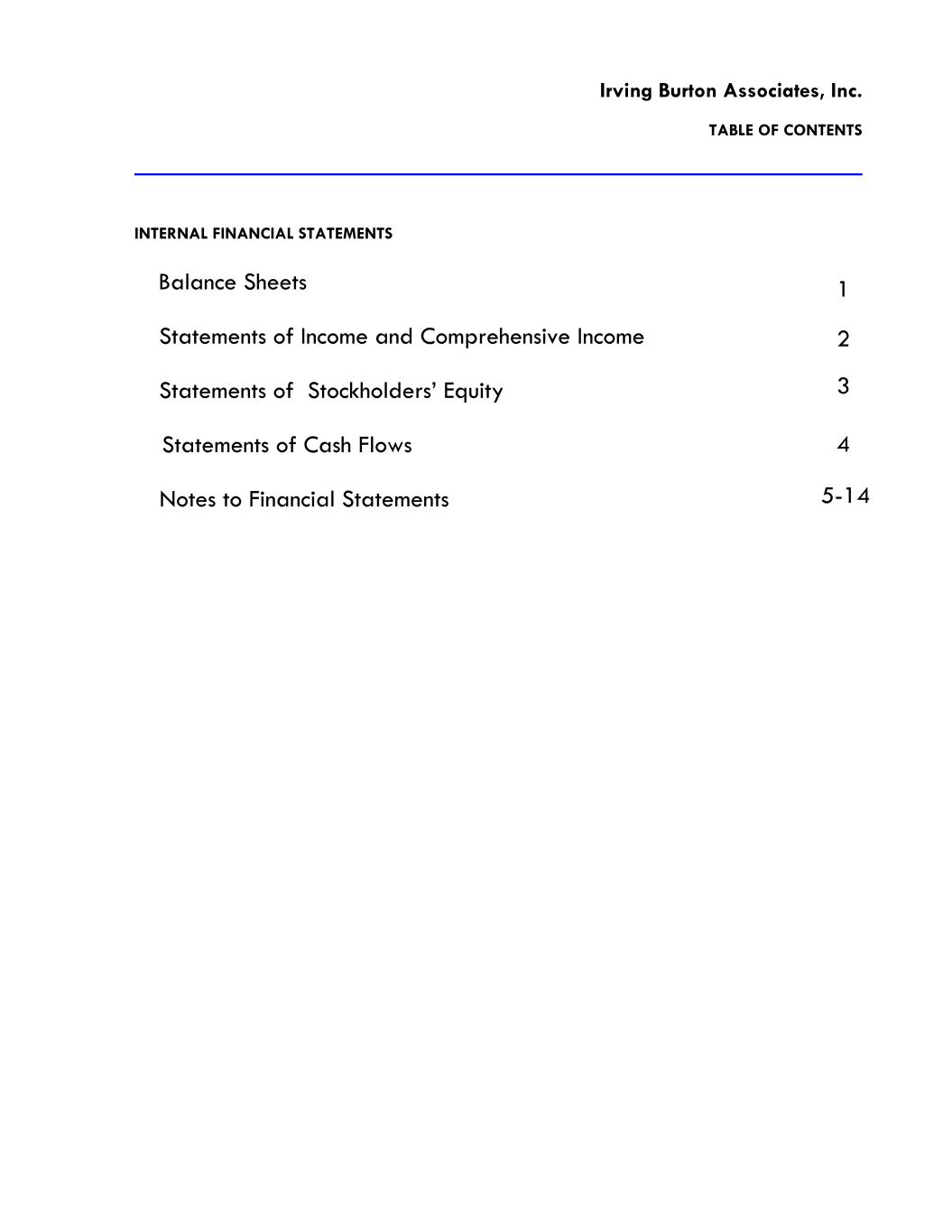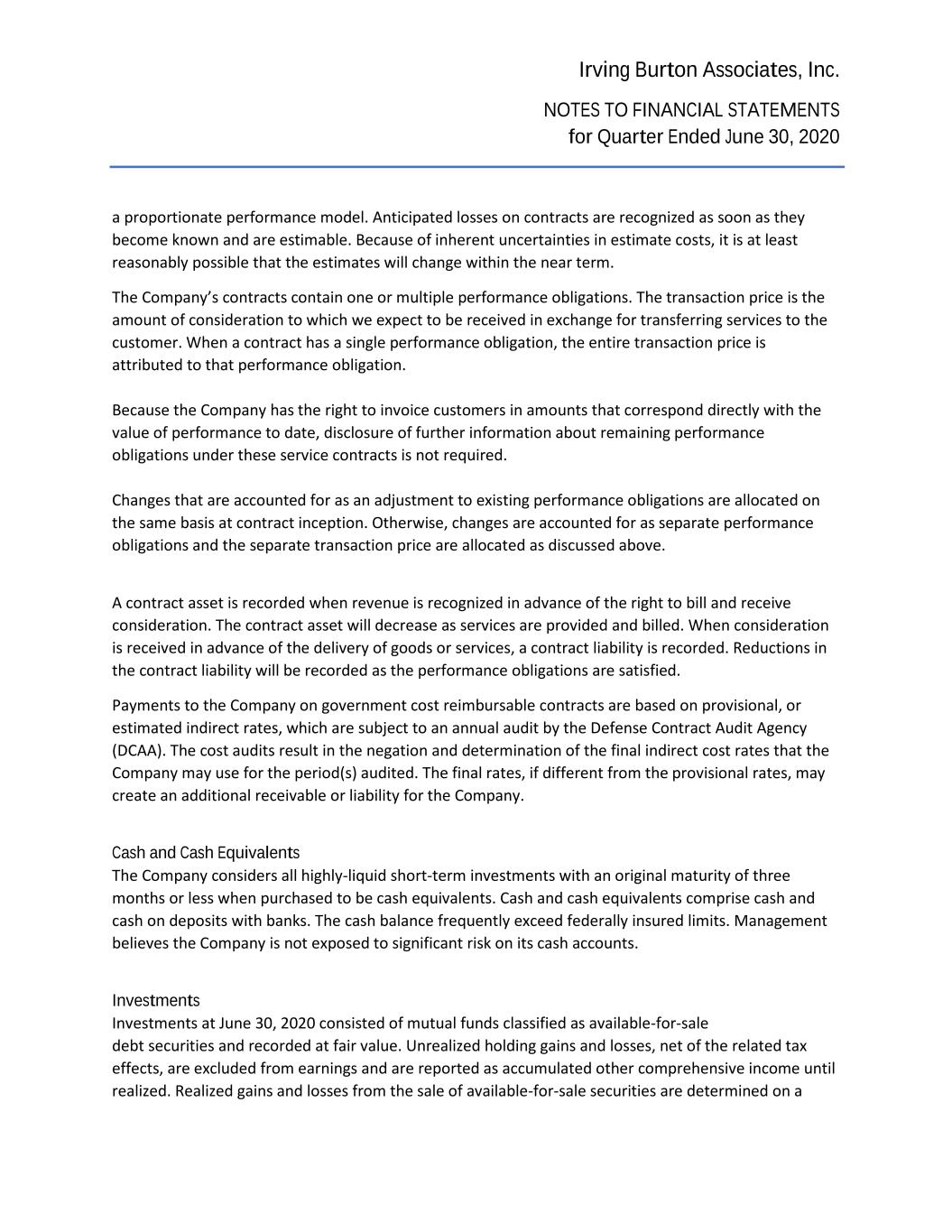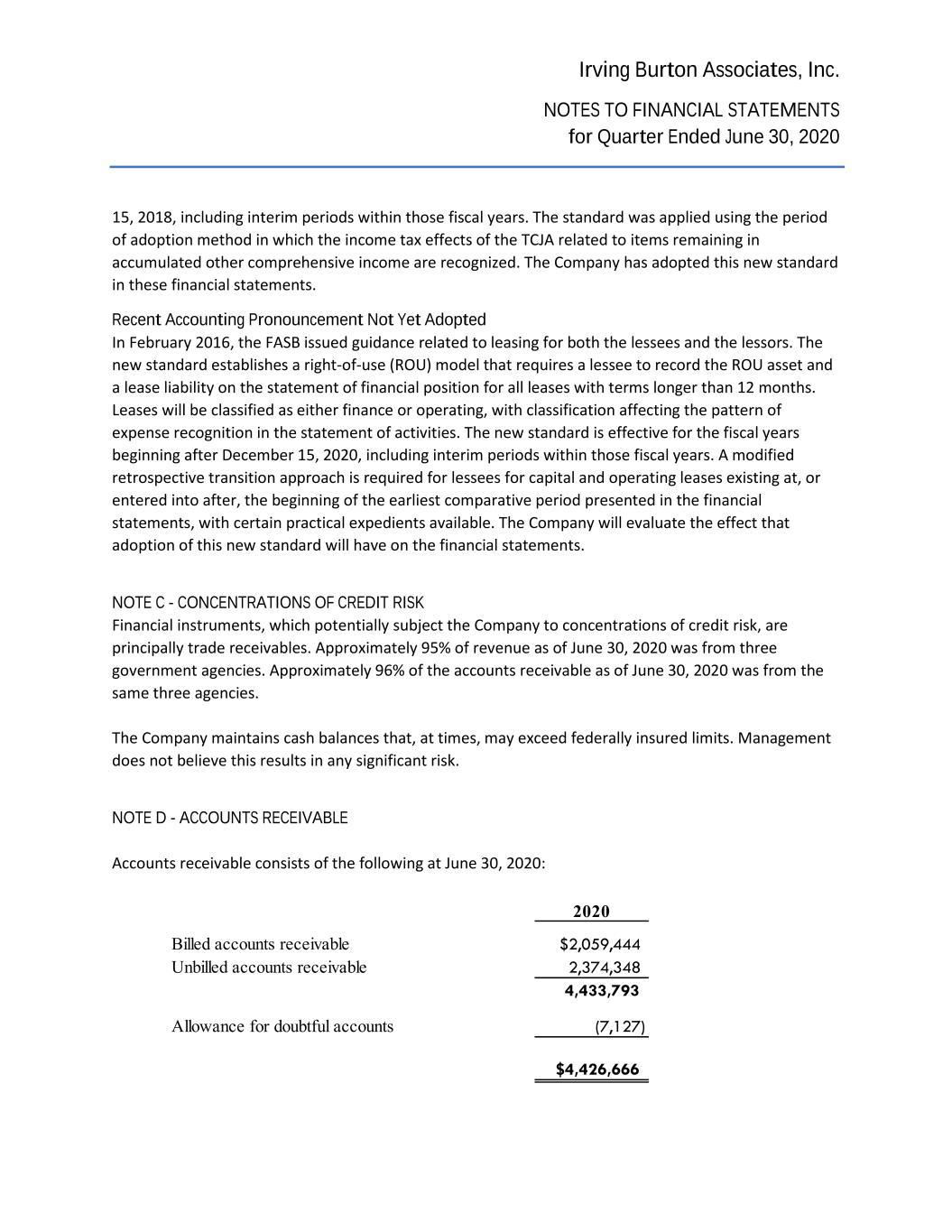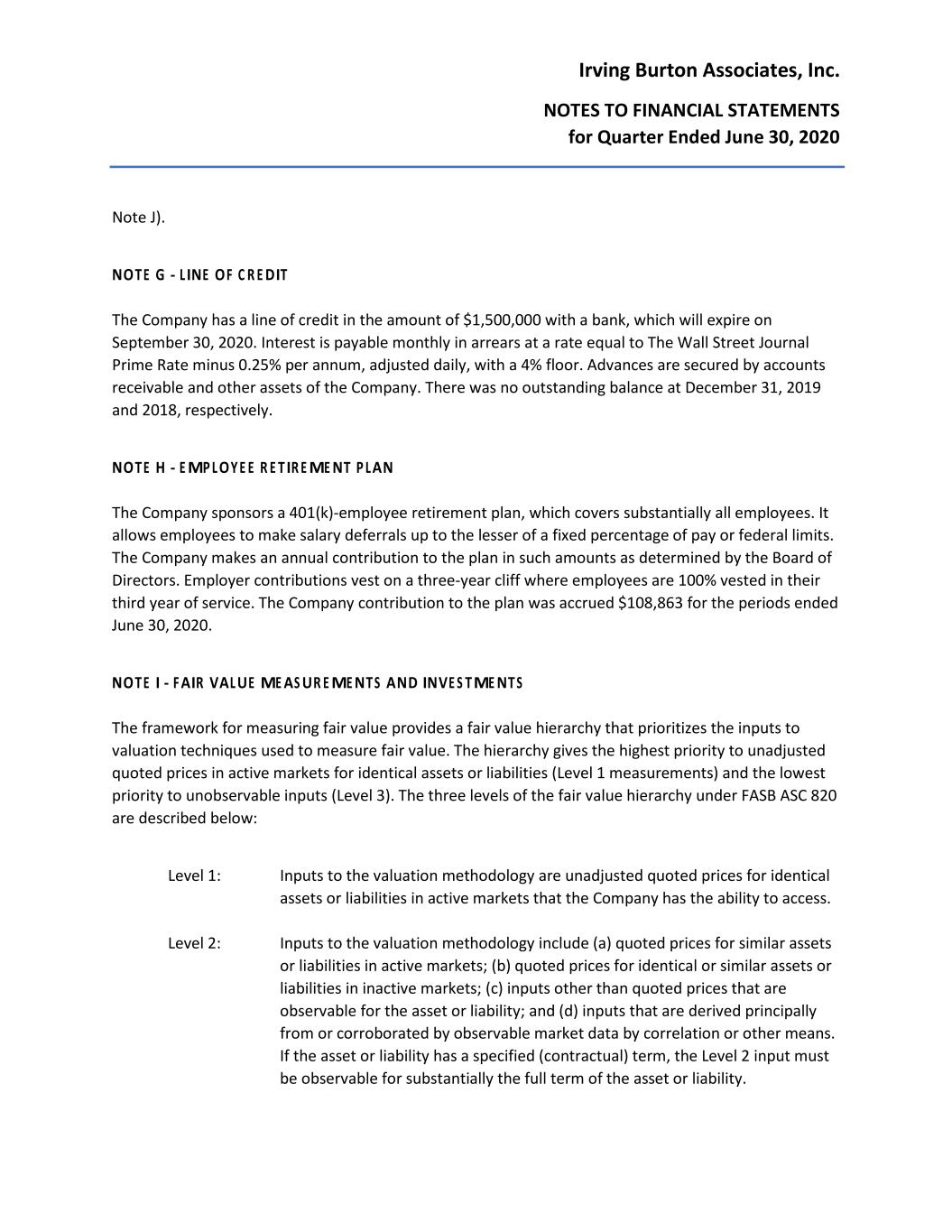Attached files
| file | filename |
|---|---|
| EX-99.4 - EX-99.4 - DLH Holdings Corp. | exhibit994proformaebit.htm |
| EX-99.3 - EX-99.3 - DLH Holdings Corp. | exhibit993unauditedpro.htm |
| EX-99.1 - EX-99.1 - DLH Holdings Corp. | auditedfs-123119xv2.htm |
| EX-23.1 - EX-23.1 - DLH Holdings Corp. | a2020ibaa-ex23cstconse.htm |
| 8-K/A - 8-K/A - DLH Holdings Corp. | form8-kxaibaacquisition.htm |

IRVING BURTON ASSOCIATES, INC. Falls Church, VA June 30, 2020 unaudited

Irving Burton Associates, Inc. TABLE OF CONTENTS INTERNAL FINANCIAL STATEMENTS 1 2 3 4 Balance Sheets Statements of Income and Comprehensive Income Statements of Stockholders’ Equity Statements of Cash Flows Notes to Financial Statements 5-14

As of June 30, 2020 As of December 31, 2019 5,332,486$ $ 1,350,113 4,380,854 4,164,851 45,812 47,434 193,778 145,559 9,952,930 5,707,957 712,299 712,299 160,515 160,515 128,884 128,884 -969,749 -961,612 31,949 40,086 512,189 1,563,547 21,883 21,883 534,072 1,585,430 TOTAL ASSETS $ 10,518,951 $ 7,333,473 LIABILITIES AND STOCKHOLDERS' EQUITY 1,526,882$ $ 458,313 468,953 474,998 536,076 356,271 186,146 32,664 119,044 104,470 763,047 763,047 3,600,148 2,189,763 375 375 28,500 28,500 RETAINED EARNINGS 6,906,958 5,135,210 -17,031 -20,376 6,918,803 5,143,710 10,518,951$ $ 7,333,473 CLASS B COMMON STOCK TOTAL LIABILITIES AND STOCKHOLDERS' EQUITY STOCKHOLDER'S EQUITY CLASS A COMMON STOCK PROVISION RATE VARIANCE UNREALIZED GAINS/LOSSES EMPLOYEE BENEFITS PAYABLE OTHER ACCRUED EXPENSES ACCRUED SALARIES PAYABLE ACCRUED LEAVE CURRENT LIABILITIES ACCOUNTS PAYABLE OTHER ASSETS LONG TERM - INVESTMENTS SECURITY DEPOSITS ACCUMULATED DEPRECIATION FIXED ASSETS FURNITURE & EQUIPMENT LEASEHOLD IMPROVEMENTS COMPUTER SOFTWARE BILLED RECEIVABLES UNBILLED RECEIVABLES PREPAID EXPENSES CURRENT ASSETS CASH IRVING BURTON ASSOCIATES BALANCE SHEETS as of June 30 unaudited

as of June 30 Three Months Ended June 30, 2020 Six Months Ended June 30, 2020 REVENUE $ 6,757,282 $ 12,952,464 DIRECT COSTS Direct Costs 4,406,137 8,177,348 Indirect costs 1,459,685 3,040,392 5,865,822 11,217,740 INCOME FROM OPERATIONS 891,459 1,734,723 OTHER INCOME (EXPENSES) INTEREST AND INVESTMENT INCOME 7,707 122,483 NET INCOME 899,167 1,857,206 OTHER COMPREHENSIVE INCOME (LOSS) Unrealized gain (loss) on debt securities - 3,345 TOTAL COMPREHENSIVE INCOME $ 899,167 $ 1,860,551 STATEMENTS OF INCOME AND COMPREHENSIVE INCOME IRVING BURTON ASSOCIATES unaudited

Class A common Stock (Voting) Class B common stock (Non-voting) Retained earnings Accumulated other comprehensive income (loss) Total BALANCE December 31, 2019 375$ 28,500$ 5,135,211$ $ (20,376) $ 5,143,710 Distributions (85,458)$ (85,458)$ Unrealized loss on debt securities 3,345$ 3,345$ Net income 1,857,206$ 1,857,206$ BALANCE June 30, 2020 375$ 28,500$ 6,906,959$ (17,031)$ 6,918,803$ IRVING BURTON ASSOCIATES STATEMENTS OF STOCKHOLDERS' EQUITY as of June 30, 2020 unaudited

CASH FLOWS FROM OPERATING ACTIVITIES Net income 1,857,206$ Changes to net income not affecting cash: Depreciation and amortization 8,137 Realized Loss on investmetns (102,473) Adjustments to reconcile net income to net cash provided (used) by operating activities: Accounts Recievable, net (214,380) Prepaid expenses (48,219) Accounts payable and accrued expenses 1,098,810 Accrued Salaries and related expenses 311,575 NET CASH PROVIDED BY OPERATING ACTIVITIES 2,910,656 CASH FLOWS FROM INVESTING ACTIVITIES Purchases of investments (527,930) Proceeds from sales of investments 1,685,106 NET CASH PROVIDED BY INVESTING ACTIVITIES 1,157,176 CASH FLOWS FROM FINANCING ACTIVITIES Distributions paid (85,458) NET CHANGE IN CASH AND CASH EQUIVALENTS 3,982,374 Cash & cash equivalents, start of period 1,350,113 CASH AND CASH EQUIVALENTS, END OF PERIOD 5,332,487$ IRVING BURTON ASSOCIATES STATEMENTS OF CASH FLOWS for the six months ended June 30, 2020 unaudited

Irving Burton Associates, Inc. NOTES TO FINANCIAL STATEMENTS for Quarter Ended June 30, 2020 NOTE A - ORGANIZATION Irving Burton Associates, Inc. (the Company) was incorporated on July 1, 1981 in the Commonwealth of Virginia. The Company provides financial management and technical support services to agencies of the federal government and the private sector in the United States of America. NOTE B - SIGNIFICANT ACCOUNTING POLICIES Basis of Accounting The books of the Company are maintained on the accrual basis of accounting, whereby revenues are recognized when they are earned and expenses are recognized when they are incurred. Use of Estimates The preparation of financial statements in conformity with generally accepted accounting principles requires management to make estimates and assumptions that affect the reported amount of assets and liabilities and disclosures of contingent assets and liabilities at the date of the financial statements and reported amounts of revenues and expenses during the reporting period. Actual results could differ from those estimates. Revenue Recognition Effective January 1, 2019, the Company adopted ASU 2014-09 Revenue from Contracts with Customers and all subsequent amendments to the ASU (collectively, “ASC 606”), and have concluded that conforming to the new standard had no impact on revenue recognized in the Company’s financial statements. ASC 606 provides for a five-step model for recognizing revenue from contracts with customers as follows: (i) identify the contract with the customer, (ii) identify the performance obligations in the contract, (iii) determine the transaction price, (iv) allocate the transaction price to the performance obligations in the contract, and (v) recognize revenue when (or as) the entity satisfies the performance obligation. Revenue is measured based on a consideration specified in a contract with a customer. The Company recognizes revenue when it satisfies a performance obligation over a period of time as the services are provided. The Company provides services, primarily for agencies of the U.S. Government, under time and materials and fixed price contracts. Revenue from time and material projects is recognized based on fixed hourly rates for direct-labor hours expended plus material and other reimbursable expenses. Revenue from fixed price contracts is billed monthly as the services are performed and recognized using

Irving Burton Associates, Inc. NOTES TO FINANCIAL STATEMENTS for Quarter Ended June 30, 2020 a proportionate performance model. Anticipated losses on contracts are recognized as soon as they become known and are estimable. Because of inherent uncertainties in estimate costs, it is at least reasonably possible that the estimates will change within the near term. The Company’s contracts contain one or multiple performance obligations. The transaction price is the amount of consideration to which we expect to be received in exchange for transferring services to the customer. When a contract has a single performance obligation, the entire transaction price is attributed to that performance obligation. Because the Company has the right to invoice customers in amounts that correspond directly with the value of performance to date, disclosure of further information about remaining performance obligations under these service contracts is not required. Changes that are accounted for as an adjustment to existing performance obligations are allocated on the same basis at contract inception. Otherwise, changes are accounted for as separate performance obligations and the separate transaction price are allocated as discussed above. A contract asset is recorded when revenue is recognized in advance of the right to bill and receive consideration. The contract asset will decrease as services are provided and billed. When consideration is received in advance of the delivery of goods or services, a contract liability is recorded. Reductions in the contract liability will be recorded as the performance obligations are satisfied. Payments to the Company on government cost reimbursable contracts are based on provisional, or estimated indirect rates, which are subject to an annual audit by the Defense Contract Audit Agency (DCAA). The cost audits result in the negation and determination of the final indirect cost rates that the Company may use for the period(s) audited. The final rates, if different from the provisional rates, may create an additional receivable or liability for the Company. Cash and Cash Equivalents The Company considers all highly-liquid short-term investments with an original maturity of three months or less when purchased to be cash equivalents. Cash and cash equivalents comprise cash and cash on deposits with banks. The cash balance frequently exceed federally insured limits. Management believes the Company is not exposed to significant risk on its cash accounts. Investments Investments at June 30, 2020 consisted of mutual funds classified as available-for-sale debt securities and recorded at fair value. Unrealized holding gains and losses, net of the related tax effects, are excluded from earnings and are reported as accumulated other comprehensive income until realized. Realized gains and losses from the sale of available-for-sale securities are determined on a

Irving Burton Associates, Inc. NOTES TO FINANCIAL STATEMENTS for Quarter Ended June 30, 2020 specific-identification basis. A decline in the market value of any available-for-sale or held-to-maturity security below cost, that is deemed to be other-than-temporary, results in an impairment to reduce the carrying amount to fair value. To determine whether impairment is other-than-temporary, the Company considers all available information relevant to the collectability of the security, including past events, current conditions, and reasonable and supportable forecasts when developing estimate of cash flows expected to be collected. Evidence considered in this assessment includes the reasons for the impairment, the severity, and duration of the impairment, changes in value subsequent to year-end, forecasted performance of the investee, and the general market condition in the geographic area or industry the investee operates in. Fair Value Reporting Unless disclosed otherwise, the Company estimates that the fair value of all financial and non-financial instruments at June 30, 2020 does not differ materially from the aggregate carrying values recorded in the accompanying balance sheets. The estimated fair value amounts have been determined by the Company using available market information and appropriate valuation methodologies. Considerable judgment is necessarily required in interpreting market data to develop the estimates of fair value, and, accordingly the estimates are not necessarily indicative of the amounts that the Company could realize in a current market exchange. Accounts Receivable The Company records accounts receivable net of an allowance for doubtful accounts. The allowance is determined based on a review of the estimated collectability of the specific accounts, plus a general provision based on historical loss experience and existing economic conditions. Accounts receivable are considered past due once they are more than 120 days old. Uncollectible amounts are charged off against the allowance for doubtful accounts once management determines an amount, or a portion thereof, to be worthless. The majority of the Company's accounts receivable is due from agencies of the federal government. Bad debt expense for the period ended June 30, 2020 totaled $0. Property and Equipment Property and equipment are stated at cost and is depreciated over the estimated useful lives of the assets (generally three to seven years) using the straight-line method. Expenditures for maintenance and repairs which do not significantly prolong the useful lives of the assets are charged to expense as incurred. Leasehold improvements are amortized over the shorter of the lease term or the life of the asset.

Irving Burton Associates, Inc. NOTES TO FINANCIAL STATEMENTS for Quarter Ended June 30, 2020 Income Taxes The Company has elected under the Internal Revenue Code to be taxed as an S Corporation. Accordingly, no provision has been made for federal income taxes, as these taxes are the responsibility of the stockholders. Certain states do not recognize S Corporation tax treatment. Under the provisions of Statement of Financial Accounting Standards ASC Topic 740, Income Taxes (ASC 740), companies are required to disclose unrecognized tax benefits. Management has evaluated the effect of the guidance provided by ASC 740, and all other tax positions that could have a significant effect on the financial statements, and determined the Company had no uncertain tax positions at June 30, 2020 that require disclosure or recognition. Generally, the Company's tax returns remain open for three years for federal income tax examination and four years for state income tax examination. New Accounting Pronouncements Adopted in 2019 In May 2014, the FASB issued guidance that supersedes previously issued guidance on revenue recognition and will apply to the Company. The main principle of this new guidance focuses on the contract between a vendor and a customer for the provision of goods and services. It attempts to depict the exchange of rights and obligations between the parties in the pattern of revenue recognition based on the consideration for which the vendor is entitled. To accomplish this objective, the standard requires five basic steps: (i) identify the contract with the customer, (ii) identify the performance obligations in the contract, (iii) determine the transaction price, (iv) allocate the transaction price to the performance obligations in the contract, and (v) recognize revenue when (or as) the entity satisfies the performance obligation. The new standard is effective for nonpublic entities for annual reporting periods beginning after December 15, 2018. The Company has adopted Topic 606 effective January 1, 2019, using a modified retrospective transition approach and have concluded that conforming to the new standard had no impact on revenue recognized in the Company’s financial statements. The Corporation applied the new revenue standard to all contracts not yet completed or substantially completed as of January 1, 2019. In January 2016, the FASB issued ASU 2016-01, Financial Instruments – Overall (Subtopic 825-10: Recognition and Measurement of Financial Assets and Financial Liabilities, and subsequently issued related ASU 2018-03, Technical Corrections and Improvements to Financial Instruments—Overall (Subtopic 825-10). These standards amend certain aspects of accounting and disclosure requirements for financial instruments. The Company has adopted this new standard in these financial statements. The accounting of the Company’s investments in debt securities was not impacted. In February 2018, the FASB issued guidance related to reclassification of certain tax effects from accumulated other comprehensive income. The standard addresses a financial reporting issue related to the tax effects that may become stranded in accumulated other comprehensive income as a result of the Tax Cuts and Jobs Act (TCJA). The standard is effective for the fiscal years beginning after December

Irving Burton Associates, Inc. NOTES TO FINANCIAL STATEMENTS for Quarter Ended June 30, 2020 15, 2018, including interim periods within those fiscal years. The standard was applied using the period of adoption method in which the income tax effects of the TCJA related to items remaining in accumulated other comprehensive income are recognized. The Company has adopted this new standard in these financial statements. Recent Accounting Pronouncement Not Yet Adopted In February 2016, the FASB issued guidance related to leasing for both the lessees and the lessors. The new standard establishes a right-of-use (ROU) model that requires a lessee to record the ROU asset and a lease liability on the statement of financial position for all leases with terms longer than 12 months. Leases will be classified as either finance or operating, with classification affecting the pattern of expense recognition in the statement of activities. The new standard is effective for the fiscal years beginning after December 15, 2020, including interim periods within those fiscal years. A modified retrospective transition approach is required for lessees for capital and operating leases existing at, or entered into after, the beginning of the earliest comparative period presented in the financial statements, with certain practical expedients available. The Company will evaluate the effect that adoption of this new standard will have on the financial statements. NOTE C - CONCENTRATIONS OF CREDIT RISK Financial instruments, which potentially subject the Company to concentrations of credit risk, are principally trade receivables. Approximately 95% of revenue as of June 30, 2020 was from three government agencies. Approximately 96% of the accounts receivable as of June 30, 2020 was from the same three agencies. The Company maintains cash balances that, at times, may exceed federally insured limits. Management does not believe this results in any significant risk. NOTE D - ACCOUNTS RECEIVABLE Accounts receivable consists of the following at June 30, 2020: 2020 Billed accounts receivable 2,059,444$ Unbilled accounts receivable 2,374,348 4,433,793 Allowance for doubtful accounts (7,127) 4,426,666$

Irving Burton Associates, Inc. NOTES TO FINANCIAL STATEMENTS for Quarter Ended June 30, 2020 Unbilled receivables are generated by differences between invoicing timing and the Company’s performance-based methodology used for revenue recognition purposes and variances between the current approved provisional billing rates and actual rates incurred at the end of the fiscal year, but not billed or yet eligible to be billed. Unbilled accounts receivable of $2,328,537 as of June 30, 2020, represents amounts to be billed in a subsequent month in accordance with the customer’s contract. Remaining balances include revenues in excess of funding, billable upon receipt of contractual modification or other modification. NOTE E - PROPERTY AND EQUIPMENT Property and equipment consists of the following at June 30, 2020: Depreciation and amortization expense for the period ended June 30, 2020 totaled $8,137. NOTE F - RELATED PARTY TRANSACTIONS RockDove Solutions, Inc. is an entity whose owners include certain stockholders of the Company. The Company also entered into a month-to-month agreement with RockDove Solutions, Inc. to provide certain accounting, site supervision and human resource services and to receive certain IT and accounting services at predetermined labor rates. Accounts receivable at June 30, 2020 includes $17,131, in amounts due from RockDove Solutions, Inc. for such services. Contract revenue for the period ended June 30, 2020 includes $26,284 of services provided under the agreement. The Company entered into a sublease agreement with RockDove Solutions, Inc. on April 1, 2019 to rent temporary off-site office space. Rent expense for the year ended December 31, 2019 includes $17,718 paid under the agreement. The sublease agreement is set to expire in February of 2020 (see 2020 Equipment 515,748.00$ Furniture and fixes 196,551 Software 128,884 Leasehold improvements 160,515 1,001,698 Accumulated depreciation and amortization (969,749) Property and Equipment, net 31,948.88$

Irving Burton Associates, Inc. NOTES TO FINANCIAL STATEMENTS for Quarter Ended June 30, 2020 Note J). NOTE G - LINE OF CREDIT The Company has a line of credit in the amount of $1,500,000 with a bank, which will expire on September 30, 2020. Interest is payable monthly in arrears at a rate equal to The Wall Street Journal Prime Rate minus 0.25% per annum, adjusted daily, with a 4% floor. Advances are secured by accounts receivable and other assets of the Company. There was no outstanding balance at December 31, 2019 and 2018, respectively. NOTE H - EMPLOYEE RETIREMENT PLAN The Company sponsors a 401(k)-employee retirement plan, which covers substantially all employees. It allows employees to make salary deferrals up to the lesser of a fixed percentage of pay or federal limits. The Company makes an annual contribution to the plan in such amounts as determined by the Board of Directors. Employer contributions vest on a three-year cliff where employees are 100% vested in their third year of service. The Company contribution to the plan was accrued $108,863 for the periods ended June 30, 2020. NOTE I - FAIR VALUE MEASUREMENTS AND INVESTMENTS The framework for measuring fair value provides a fair value hierarchy that prioritizes the inputs to valuation techniques used to measure fair value. The hierarchy gives the highest priority to unadjusted quoted prices in active markets for identical assets or liabilities (Level 1 measurements) and the lowest priority to unobservable inputs (Level 3). The three levels of the fair value hierarchy under FASB ASC 820 are described below: Level 1: Inputs to the valuation methodology are unadjusted quoted prices for identical assets or liabilities in active markets that the Company has the ability to access. Level 2: Inputs to the valuation methodology include (a) quoted prices for similar assets or liabilities in active markets; (b) quoted prices for identical or similar assets or liabilities in inactive markets; (c) inputs other than quoted prices that are observable for the asset or liability; and (d) inputs that are derived principally from or corroborated by observable market data by correlation or other means. If the asset or liability has a specified (contractual) term, the Level 2 input must be observable for substantially the full term of the asset or liability.

Irving Burton Associates, Inc. NOTES TO FINANCIAL STATEMENTS for Quarter Ended June 30, 2020 Level 3: Inputs to the valuation methodology are unobservable and significant to the fair value measurement. The asset’s or liability’s fair value measurement level within the fair value hierarchy is based on the lowest level of any input that is significant to the fair value measurement. Valuation techniques maximize the use of relevant observable inputs and minimize the use of unobservable inputs. Following is a description of the valuation methodologies used for assets measured at fair value. Mutual Funds These funds are valued at the daily closing price as reported by the fund. Mutual funds held by the Plan are generally open-end mutual funds that are registered with the Securities and Exchange Commission. These funds are required to publish their daily net asset value (NAV) and to transact at that price. The mutual funds held by the Company are deemed to be actively traded. The availability of market data is monitored to assess the appropriate classification of investments within the fair value hierarchy. Changes in economic conditions or valuation techniques may require the transfer of investments from one fair value level to another. In such instances, the transfer is reported at the end of the reporting period. The Company evaluates the significance of transfers between levels based upon the nature of the investment and size of the transfer relative to total net assets available for benefits. For the period ended June 30, 2020, there were no significant transfers into or out of Levels 1, 2 or 3. The Company’s available for sale investments are reported at fair value in the accompanying balance sheet at June 30, 2020 as follows: Fair Value Quoted Prices in Active Markets for Identical Assets Significant Other Observable Inputs Significant Unobservable Inputs (Level 1) (Level 2) (Level 3) Mutual funds 512,189 512,189 - -

Irving Burton Associates, Inc. NOTES TO FINANCIAL STATEMENTS for Quarter Ended June 30, 2020 NOTE J - OPERATING LEASES The Company has entered into various non-cancelable operating lease agreements for office space in two locations expiring through 2020. The Company is committed to pay a portion of the actual operating expenses under certain of these lease agreements. These operating expenses are not included in the table below. Certain of these arrangements have escalating rent payment provisions. The Company recognizes rent expense under such arrangements on a straight-line basis. At June 30, 2020, future minimum payments under non-cancelable operating leases were as follows: Rent expense under operating leases was $147,653 for the periods ended June 30, 2020. NOTE K - CASH FLOW INFORMATION There was no interest paid for the period ended June 30, 2020. NOTE L - SUBSEQUENT EVENTS On September 30, 2020 the Company was acquired by DLH Holdings Corp (“DLH”). The all-cash transaction was for 100% of our outstanding common stock. The initial purchase price was $32 million and was financed by their secured credit facility. Outside of the event described above, management evaluated the activity of the Company through November 9, 2020, the date the financial statements were available to be issued and determined that there are no subsequent events have occurred that would require recognition in the financial statements or disclosure in the notes to the financial statements. For Year Ending December 31, 2021 $209,891 2022 196,751 Thereafter 0 $ 406,642
